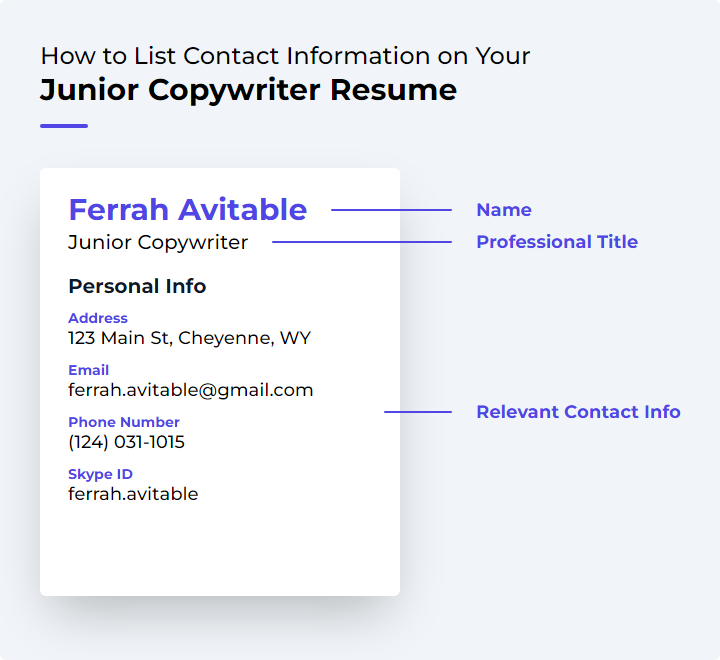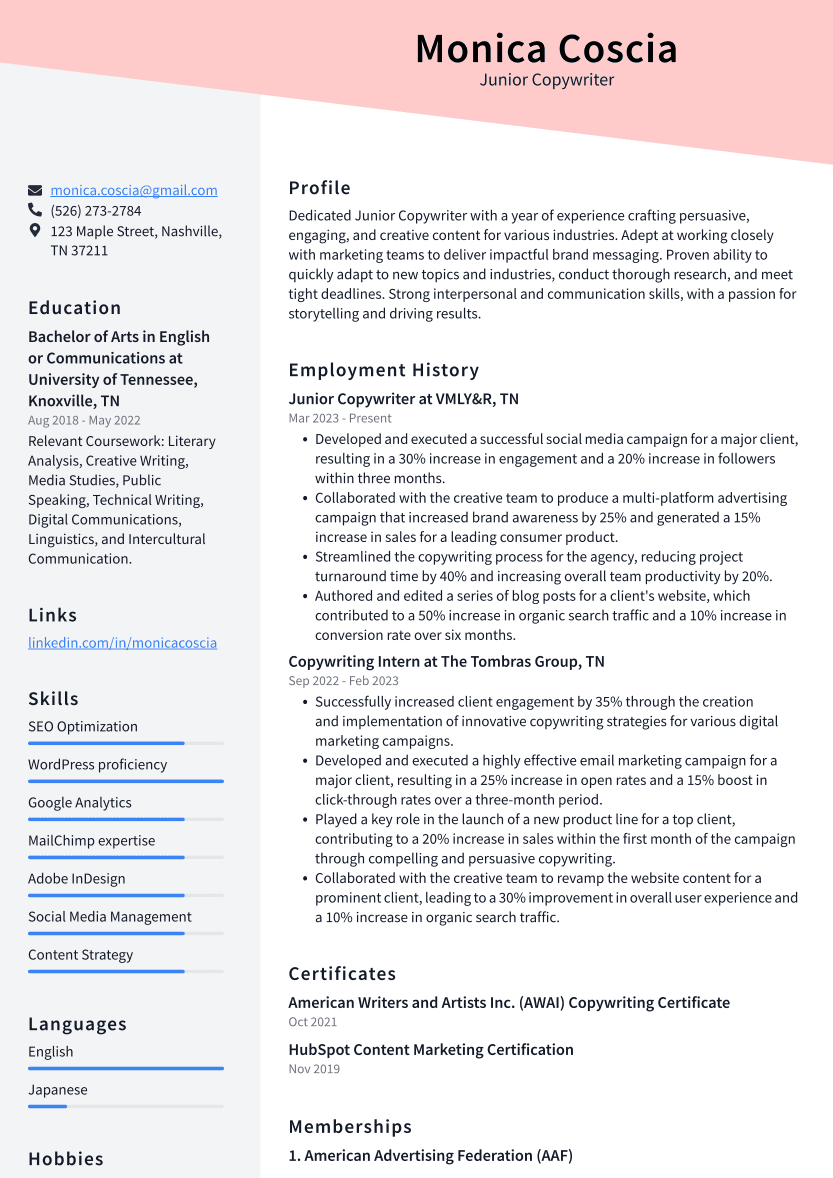Junior Copywriter Resume Examples
Writing a great junior copywriter resume is important because it is one of the first things a potential employer will see when they are considering you for a position. It is your opportunity to make a good first impression and sell yourself as the best candidate for the job.
Create your resume
Select from 7 professional resume templates
If you're looking for inspiration when it comes to drafting your own junior copywriter resume, look no further than the samples below. These resumes will help you highlight your experience and qualifications in the most effective way possible, giving you the best chance of landing the junior copywriter job you're after.
Essential Components of a Junior Copywriter Resume
For aspiring junior copywriters, a well-crafted resume is a crucial tool to showcase their skills and potential to employers. It's essential to highlight key elements that demonstrate your ability to produce compelling content, understand marketing strategies, and contribute creatively to a team. As the first impression you make, your resume should effectively communicate your qualifications and enthusiasm for the role.
This guide will delve into the various components of a junior copywriter's resume, discussing the importance of each and what to include. We'll also provide tips to make each section stand out.
1. Contact Information
As a Junior Copywriter, your resume must begin with clear contact information, prominently placed at the top. This section serves as an introduction and provides employers with the necessary details to contact you.

Include your full name, phone number, and a professional email address. Avoid using your current work email or unprofessional-sounding addresses. Consider adding your LinkedIn profile URL and links to an online portfolio or personal website to showcase your work, such as blog posts or ad copy samples.
- Note: Avoid sharing excessive personal information like marital status, age, or home address, as it's unnecessary for job applications and could compromise your privacy.
The contact information section should be concise yet comprehensive, ensuring employers can easily reach out to you.
2. Objective Statement
The "Objective Statement" is a brief and impactful introduction to your resume. It should summarize your professional identity and career aspirations, highlighting your goals and relevant skills.
An effective objective statement for a Junior Copywriter might mention your passion for creating engaging content, your ability to thrive under pressure, or your versatility in adapting writing styles for different audiences.
Example: "Detail-oriented junior copywriter with a Bachelor’s degree in English Literature seeking to leverage my skills in crafting impactful marketing content. Experienced in SEO optimization and social media management, I aim to enhance brand visibility and engagement."
The objective statement offers a snapshot of your professional profile, emphasizing your skills and ambitions as a Junior Copywriter.
3. Skills and Competencies
The "Skills and Competencies" section is a showcase of your abilities and knowledge relevant to copywriting. Highlight essential skills such as writing proficiency, creativity, research capabilities, SEO knowledge, time management, adaptability, communication, attention to detail, basic design understanding, and marketing principles.
Provide concrete examples from past experiences to demonstrate how you've applied these skills effectively.
4. Educational Background
The "Education History" section outlines your academic qualifications, which typically include a Bachelor's degree in fields like English, Journalism, Marketing, or Communications. List your degrees in reverse chronological order, including the institution, location, degree obtained, and field of study.
Emphasize relevant coursework or projects and consider mentioning additional education such as Master’s degrees or certifications. Ensure this section complements the other parts of your resume, such as Skills and Experience.
5. Work Experience/Internship Experience
The "Work History/Internship Record" section is where you detail your practical experience. Include internships, part-time jobs, or freelance work, focusing on responsibilities that align with copywriting skills.
For each role, list your job title, company name, duration of employment, a brief company description, and your key responsibilities and achievements, using action verbs and quantifiable results.
Internships in advertising or related fields should be highlighted, as they provide valuable industry insight.
6. Portfolio or Examples of Work
Include a portfolio or work samples in your resume to provide tangible proof of your writing skills and creativity. Showcase a variety of pieces, such as articles, blog posts, and social media content, ensuring they are error-free and represent your best work.
Highlight any samples that have led to positive outcomes, and keep your portfolio updated with new work. Consider creating an online portfolio for easy sharing with potential employers.
7. References or Testimonials
The "References or Testimonials" section can enhance your credibility by featuring endorsements from individuals familiar with your work. Include references from educators, internship supervisors, or team members, and testimonials from past employers or clients who can vouch for your abilities.
Always obtain permission before listing someone as a reference or using their words as a testimonial. Keep this section brief, selecting only the most impactful endorsements.
This section reinforces the skills and experiences listed on your resume, providing employers with external validation of your qualifications for a junior copywriter role.
